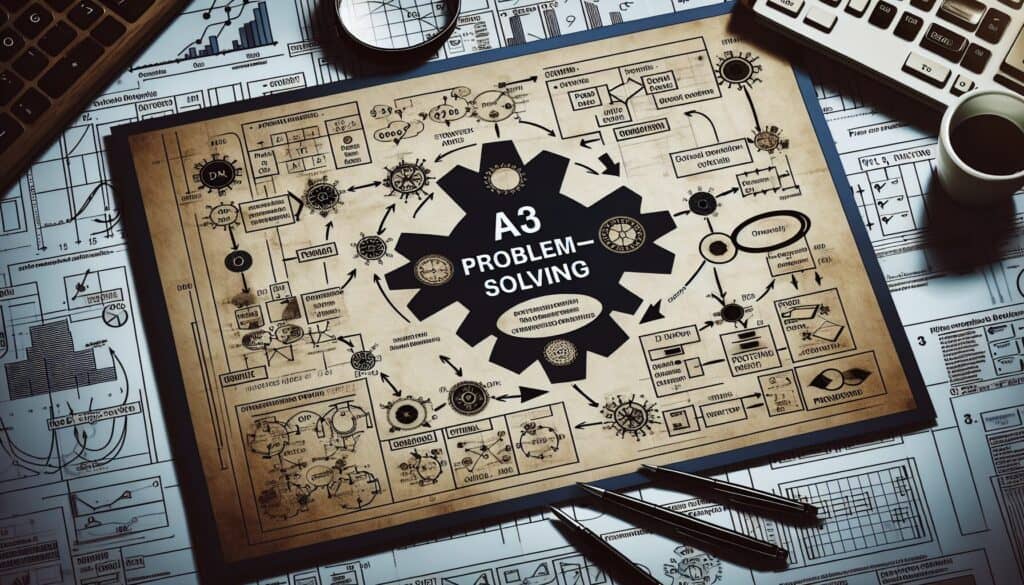A structured problem-solving and continuous improvement approach, typically documented on a single A3-sized sheet of paper that follows a logical thinking process, thus “A3-Denken“ (often aligned with PDCA).
- Methodologien: Wirtschaft, Lean Sigma, Herstellung, Projektmanagement, Qualität
A3-Denken

A3-Denken
- Kontinuierliche Verbesserung, Schlanke Fertigung, Plan-Do-Check-Act (PDCA), Problemlösungs-Techniken, Prozessverbesserung, Qualitätskontrolle, Qualitätsmanagement, Ursachenanalyse, Teamarbeit
Zielsetzung:
Wie es verwendet wird:
- The A3 report typically includes sections for: Background/Problem Statement, Current Condition, Goal/Target Condition, Root Cause Analysis, Proposed Countermeasures, Implementation Plan, Follow-up/Results, and Standardization. It's a collaborative tool.
Vorteile
- Promotes clear and concise communication of problems and solutions; Encourages systematic thinking and data-driven analysis; Facilitates collaboration and knowledge sharing; Serves as a powerful coaching and mentoring tool.
Nachteile
- Can be challenging to condense complex problems onto a single A3 sheet effectively; Requires skill in facilitation and root cause analysis; May be perceived as just a documentation exercise if the underlying thinking process is not embraced.
Kategorien:
- Lean Sigma, Herstellung, Problemlösung, Projektmanagement, Qualität
Am besten geeignet für:
- Solving problems systematically, driving continuous improvement, and fostering a culture of learning and clear communication, often within a Lean environment.
A3 Thinking finds its applications across various sectors including manufacturing, healthcare, and software development, particularly within organizations that prioritize Lean methodologies. For instance, in manufacturing, A3 reports can be utilized to tackle production inefficiencies by analyzing workflow bottlenecks and developing targeted solutions, while in healthcare, these reports can help streamline patient care processes by identifying root causes of delays in treatment. The methodology is most effective during the problem identification phase, where teams can collaboratively articulate issues and devise a common understanding before moving into solution development. Participants typically include cross-functional team members, project managers, and stakeholders who bring diverse perspectives to the table, which enhances collaboration and ensures that all aspects of a problem are addressed. The A3 report structure provides a clear framework that guides teams through systematic analysis and encourages the use of data-driven decision-making, which can lead to sustainable improvement initiatives. With ongoing follow-up and results tracking, organizations can establish standard practices that integrate lessons learned, promoting a continuous improvement culture that values learning and adaptability among team members. The clarity of communication inherent in A3 reports serves as a mentoring tool that allows less experienced team members to efficiently grasp problem-solving techniques from their peers, thereby building a stronger foundation for future projects.
Die wichtigsten Schritte dieser Methodik
- Define the background and problem statement clearly.
- Analyze the current condition with relevant metrics.
- Set a specific goal or target condition to achieve.
- Conduct root cause analysis using appropriate techniques.
- Propose countermeasures based on the root causes identified.
- Develop a detailed implementation plan for the countermeasures.
- Establish a follow-up process to monitor results.
- Document lessons learned and standardize successful practices.
Profi-Tipps
- Involve cross-functional teams early to enhance diverse perspectives in problem-solving.
- Utilize data visualization methods, like flowcharts or graphs, to clarify current conditions and root cause analysis.
- Establish clear metrics for success at the goal/target condition stage to measure impact effectively post-implementation.
Verschiedene Methoden lesen und vergleichen, Wir empfehlen die
> Umfassendes Methoden-Repository <
zusammen mit den über 400 anderen Methoden.
Ihre Kommentare zu dieser Methodik oder zusätzliche Informationen sind willkommen auf der Kommentarbereich unten ↓ , sowie alle ingenieursbezogenen Ideen oder Links.
Verwandte Artikel
Management der Produktionsabläufe (MOM)
Fertigungsausführungssystem (MES)
Produktionslenkungsplan
Manuelle Prüfung
Bewertungsbögen für die manuelle Handhabung (MAC)
ManTRA (Instrument zur Risikobewertung manueller Tätigkeiten)